The go wake zone
When crankbaits become wakebaits, the results are explosive
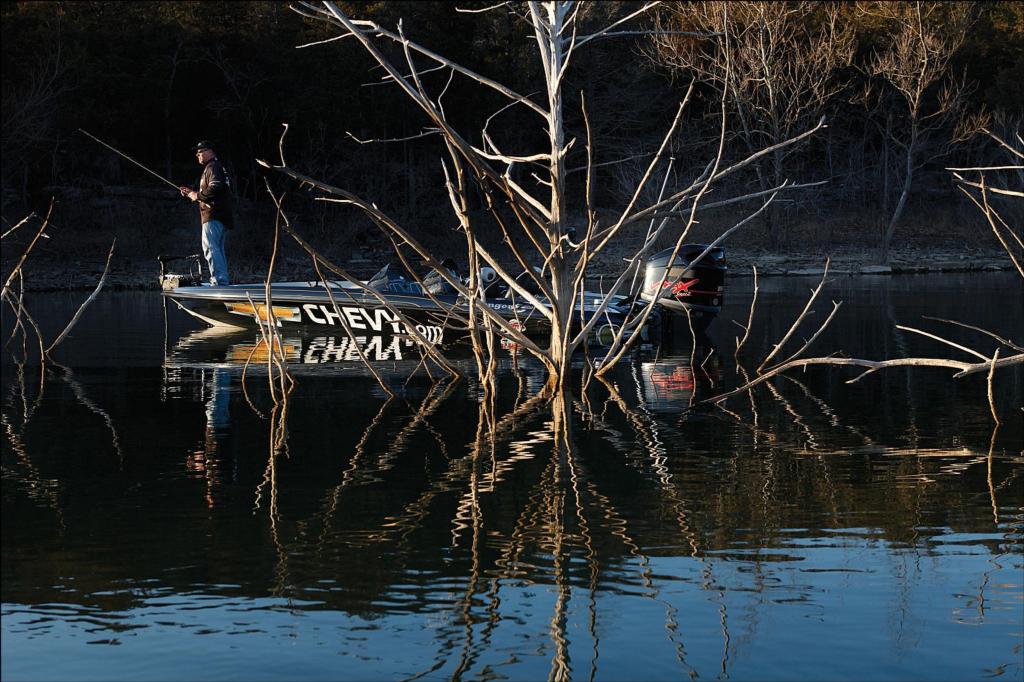
————————————–
Editor’s note: This is just one article from a recent issue of FLW Outdoors Magazine, which publishes both a Bass Edition and a Walleye Edition. To learn more about the magazine and how to subscribe, click here.
————————————–
One of the perks of being an established professional bass angler is getting to try your sponsors’ lures before they go on the market. Chevy pro Dave Lefebre of Union City, Pa., made the most of this advantage when Rapala sent him some prototype DT Fat crankbaits.
The rotund, wide-wobbling balsa lures immediately got Lefebre excited about how well they waked the surface. The No. 1 shallow-running model stayed on the surface with the rod held low during the retrieve, while a high rod tip was enough to keep the deeper-diving No. 3 wiggling on top.
Within weeks, Lefebre had one rigged on his deck in case he came across the “right stuff” while fishing an FLW Series Eastern Division tournament at Lake Okeechobee. Sure enough, things looked right when Lefebre’s boat broke through a wall of bulrushes into a protected pocket surrounded by tall 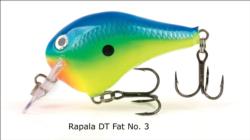 grass. Scattered about the shallows were sparse patches of peppergrass and pencil reeds, with perfect lanes in between to wake a crankbait. It didn’t take long before a 7-pounder inhaled the lure as it waked past an isolated pencil reed. While the lure was never part of his main technique, by the end of the tournament, the wakebait had caught some key fish to help Lefebre claim 14th place.
grass. Scattered about the shallows were sparse patches of peppergrass and pencil reeds, with perfect lanes in between to wake a crankbait. It didn’t take long before a 7-pounder inhaled the lure as it waked past an isolated pencil reed. While the lure was never part of his main technique, by the end of the tournament, the wakebait had caught some key fish to help Lefebre claim 14th place.
Needless to say, Lefebre had some positive things to report back to Rapala after the trip. And he has had many more trips like it in the two years since. In fact, the DT Fat has performed well enough to earn a place in the small tackle box that houses Lefebre’s proven go-to lures.
“I don’t carry much tackle in my boat,” Lefebre said, “but I always have two or three DT Fats in my box of favorites.”
While all topwater techniques are fun, waking round-body crankbaits may take the crown. It is simple to do, and it garners some explosive strikes. Plus, there are few techniques that can keep an angler as excited for the bite as a crankbait wiggling and wobbling across the surface.
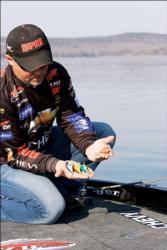
Waking crankbaits galore
While the DT Fat happens to be Lefebre’s favorite waker, it is far from the only one on the market. Actually, almost any shallow-running crankbait can be waked. All it takes is the right amount of buoyancy, wobble and retrieve speed.
Because the technique requires the lure to run on or just under the surface, a high-buoyancy crankbait makes it easier to accomplish.
Another critical factor when choosing a wakebait is that it begins waking the surface the instant the retrieve begins. Since it is much easier to get a wide-wobbling square-bill crankbait to wobble, those tend to get the call from most pros. However, round-bill crankbaits and minnow baits can work and 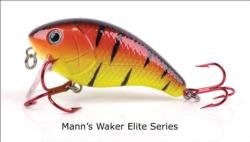 actually are favorites of some pros (see sidebar). Round bill or square, the best indicator of a good waking crankbait tends to be a steep lip angle.
actually are favorites of some pros (see sidebar). Round bill or square, the best indicator of a good waking crankbait tends to be a steep lip angle.
Finally, the right retrieve speed can turn most any shallow crankbait into a surface lure. Mann’s Bait Company started the waking craze 21 years ago when it introduced the 1-Minus, which dives no deeper than 12 inches. By raising the rod tip during the retrieve, the lure will run just beneath the surface, creating a nice wake at even high speeds. Other lures, like the No. 3 DT Fat, will require not only a high rod tip, but a much slower retrieve speed to keep it on the surface. Sometimes this is a plus, other times it won’t get a reaction, so it is good to carry multiple wakebaits.
Wake up
The beauty of waking a crankbait, outside of the tremendous topwater strikes, is the ability to cover water and call in fish. Wakebaits are “water-covering machines” to Lefebre, making them ideal search lures. Bass rarely see them, so a wakebait generally fares better in tournaments than lures bass see every day, such as a spinnerbait. Plus, most other topwaters require some sort of cadence to work, which slows down the retrieve. The exception is a buzzbait. However, buzzbaits are typically big-fish lures, and wakebaits tend to get more strikes from bass of all sizes.
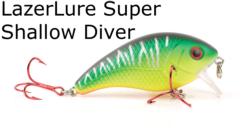 Meanwhile, the waking and bulging on the surface create a large disturbance on the water to draw attention, even if there is some chop on the water. If the fish are active, burning and bulging a crankbait is a great call. If the bass are subdued, a slower-moving wakebait still has a lot of action without running off fish at high speeds.
Meanwhile, the waking and bulging on the surface create a large disturbance on the water to draw attention, even if there is some chop on the water. If the fish are active, burning and bulging a crankbait is a great call. If the bass are subdued, a slower-moving wakebait still has a lot of action without running off fish at high speeds.
While waking minnow baits can be good in cold water, waking a crankbait is not a technique for sluggish, chilled bass. Lefebre doesn’t tie on his waking lures until the water temperature climbs to the upper 50s come spring. After that, the technique can goad strikes throughout the summer and into fall.
Regardless of the season, the thing to look for that makes the technique go is shallow vegetation. Wakebaits can be used around vertical or matted vegetation and around submerged grasses, though each needs to have the right stuff, like Lefebre looked for at Okeechobee. If it breaks the surface, like reeds, tules, pads or even hydrilla that has topped out, make sure the vegetation is sparse enough to have open lanes for casting. Meanwhile, the technique is great for casting over flats of hydrilla, milfoil and other submerged vegetation that tops out a foot or so beneath the surface. Try to make the lure 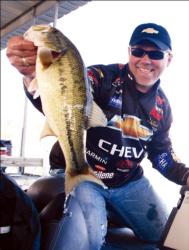 travel over holes in the grass like you would if it were matted and you were fishing with a hollow frog.
travel over holes in the grass like you would if it were matted and you were fishing with a hollow frog.
During an FLW American Fishing Series tournament at the Potomac River in June 2009, Lefebre was fishing a milfoil flat behind an island off the main river, where the water was sheltered and calm. In previous Potomac River tournaments, Lefebre had done well fishing matted milfoil with a jig during low tide. However, the weather and the moon phases held the water 18 inches over the grass throughout most of the tournament. The jig bite was practically nonexistent. Lefebre resorted to waking a DT Fat over darker clumps of grass that he could see 6 to 12 inches beneath the surface and wound up with a third-place finish.
The area of the Potomac Lefebre was fishing during the tournament also had another key component for the technique: stained water. While waking crankbaits will work in clear water, the action and wake is often too aggressive in those conditions. Thus, bright colors like chartreuse are often the best so bass can find them above the weeds and in the stain.
As with any lure, experiment with retrieve speeds to determine how the bass want it. Some days they will want it burned, so a lure with a very steep lip angle will be necessary. Other days a slow to medium speed will do the trick, so the crankbait options expand.
If the bass like the slower retrieve, it is common to see them tailgating the lure for long stretches. To most, the inclination would be to speed up when this happens, but Lefebre warned against it.
“Never change your cranking speed when (a bass is following the lure),” Lefebre said. “If you do, the bass will disappear. Just keep winding steadily and the bass will devour it.”
Another trick comes when the lure clears the cover. Instead of keeping the lure on the surface long past the edge, lower the rod tip and crank the lure down beneath the surface as it skims by the last few stalks. This gives bass a different look, and it can often trigger strikes from bass hanging on the cover’s edge.
Open-water waking
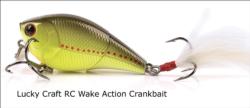 Although waking a crankbait is mainly reserved for around shallow grass, Lefebre has been known to pull bass up from the depths with the technique. On the last day of the FLW Series Eastern Division event at Clarks Hill Lake in October 2008, Lefebre was poised to qualify for the Forrest Wood Cup. However, his best spot – a bare hump that topped out in 10 feet of water – wouldn’t produce. The topwater plugs and spinnerbaits that worked the first two days only garnered a couple of bites early. Then there was nothing.
Although waking a crankbait is mainly reserved for around shallow grass, Lefebre has been known to pull bass up from the depths with the technique. On the last day of the FLW Series Eastern Division event at Clarks Hill Lake in October 2008, Lefebre was poised to qualify for the Forrest Wood Cup. However, his best spot – a bare hump that topped out in 10 feet of water – wouldn’t produce. The topwater plugs and spinnerbaits that worked the first two days only garnered a couple of bites early. Then there was nothing.
Figuring there were fish still in the area that just wouldn’t commit to fast-moving lures, Lefebre pulled out a wakebait. He zinged it far out over the hump and waked it slowly across the surface. The changeup put four bass in his livewell, including a 4-pounder, and he drove home after the tournament sitting in fourth place in the FLW Series Eastern Division Angler of the Year standings, in position to make the Forrest Wood Cup.
The reason he chose a wakebait goes back to what was said earlier about having a lot of action without a lot of forward movement. Basically, a slow-moving wakebait creates the illusion of being a fast lure without actually moving fast. Considering the bass on that particular hump had been liking fast-moving lures, giving them the same action at a different speed hit on all their buttons to make them bite.
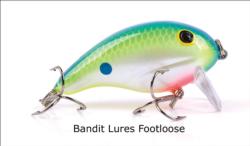
The other notable thing about the tournament was Lefebre opted for a shad color instead of chartreuse. In clear, open water, the lure will be in plain view of bass instead of obscured by cover. Plus, the lure will be moving slowly, allowing even more scrutiny. The more natural the color, the better the chances bass think the lure is something they want to eat.
Waking tackle
While wakebaits are basically crankbaits, normal cranking gear won’t do for this technique. The reels  can remain the same, but rods and line need to be adapted to match the conditions.
can remain the same, but rods and line need to be adapted to match the conditions.
When fishing shallow cover, Lefebre opts for a 6-foot, 6-inch, medium-action Setyr rod. The short rod helps make accurate casts to and in between shallow visible cover. He will also bulk to 15- to 20-pound fluorocarbon line to prevent break-offs. Although fluorocarbon sinks, it won’t impair the waking retrieve on short to medium casts because so little of it touches the water.
In open water, however, long casts are a must. So Lefebre favors a 7-foot, 6-inch, medium-action Setyr Tactical Series Crankin rod. He also switches to 8- or 10-pound monofilament to ensure the lure stays on the surface the entire retrieve.
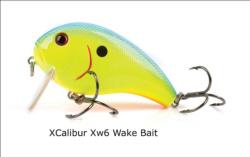 After all, that is what waking crankbaits is all about. Creating havoc on the surface, both with the lure and with bass blowing up on them.
After all, that is what waking crankbaits is all about. Creating havoc on the surface, both with the lure and with bass blowing up on them.
Treble swapping
Wakebait water is not typical cranking water. There is usually a lot of cover that can help bass straighten hooks.
To fight this, Chevy pro Dave Lefebre exchanges the original hooks on his wakebaits for heavy Gamakatsu trebles of the same size. He also adds a little extra attraction to the tail.
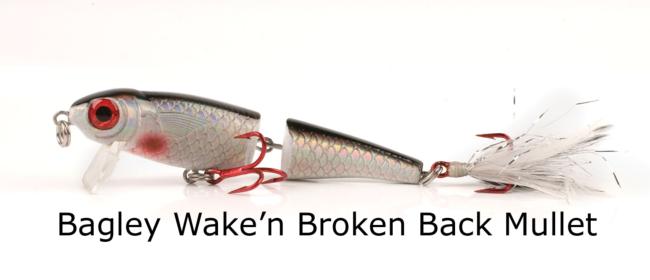
“Lately, I’ve been playing with white feathered trebles on the back hooks of my wakebaits,” Lefebre said. “The feather accentuates the wide wobble. On a long cast, all you can see is that white feather whipping back and forth. I think the bass see that, too.”
Waking floating minnow lures
Isn’t waking a crankbait the same thing as waking a floating minnow? Not even close.
“They are totally different tactics,” said FLW Tour pro Dave Lefebre.
While crankbaits have a wide, loud wobble to them, minnow baits tend to have subtle rolling actions that excel in clear water. The most notorious of these floating minnows is the Bomber Long A. To wake a Long A, reel the lure just fast enough to keep it on the surface and create a wake. Although this technique was kept quiet for 20 years, the 2006 FLW?Tour event at Beaver Lake revealed it to the bass fishing world.
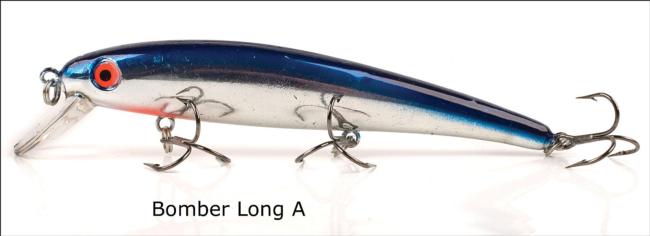
Waking a Long A works only under very specific conditions, and the windows are short and “fragile.” Some of the conditions are still kept seret by the pros. However, we do know they include clear, smooth water and prespawn water temperatures around 50 degrees.